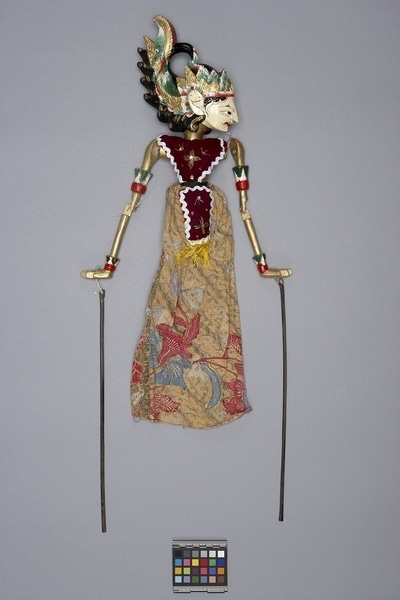Rod Puppet Item Number: Ib394 a-d from the MOA: University of British Columbia


Description
Three-dimensional male humanoid puppet: large head (part b) fits into body with skirt (part a), and a control rod (part c) with a long shaft that passes through the body and fits into the neck of the figure's head. The body has jointed arms, each with a long controlling rod attached. One arm (part d) has become detached from the body at the shoulder. White face positioned downwards; small white eyes, straight pointed nose. Pupils, hair, moustache, facial details in black. Large black curl (gelung supit urang) headdress with diadem (jamang) and Garuda Mungkur; long, textured hair in seven locks with gold highlights. Gold neck and torso; arms have red, white, and green ornaments at wrists and biceps. Right arm detached at shoulder. Hands held flat and bent back at wrist. Purple triangular chest covering and rectangular apron with black waistband. Garments have white wavy trim, sequins and twisted wire decoration. Apron has yellow frills at bottom. Long batik skirt in orange, blue, lavender, and red.
History Of Use
Javanese puppetry as an art form probably developed by the 11th century. Wayang golek puppets of western Java appeared during the 16th century. Originally the plays depicted Javanese mythology, but after the Indian conquest of Java the Hindu epics, Ramayana and Mahabharata, were incorporated into the cycles, which comprise about 200 plays. A dalang (puppet master) performs the plays to celebrate important occasions, usually in three acts, with vocal and instrumental accompaniment. Typically they serve a moral and religious purpose, and more recently, one of political commentary. Satria Gondrong is a youthful and noble warrior who is characterized by his name, which can be translated ôknight with the long hair'. He is found in all cycles, but is particularly involved in the conflict between the Pandawa brothers and their usurpers, the Kurawas, in the Mahabharata cycle.
Iconographic Meaning
Each puppet is characterized by its wanda, a Javanese word which describes the specific mixture of elements of size, form, colour, ornamentation and carving. Position and colour of face, position of hands, colour and small size of torso suggest nobility, virtue, and spirituality. Headdress with Garuda Mungkur, batik, and arm ornaments indicate high nobility. Character identified by almost exact correspondence with standard form of Satria Gondrong.
Cultural Context
Theatrical performance.
Item History
- Made in Java, Indonesia
- Owned by Donald Bone before January 4, 1980
- Received from Donald Bone (Seller) and Museum of Anthropology Donations Fund (Funding source) on January 4, 1980
What
- Name
- Rod Puppet
- Identification Number
- Ib394 a-d
- Type of Item
- puppet
- Material
- wood, fibre, paint and cotton fibre
- Manufacturing Technique
- carved, woven, sewn, painted and tied
- Part A
- height 60.0 cm, width 22.0 cm, depth 6.5 cm
- Part B
- height 21.0 cm, width 15.0 cm, depth 8.0 cm
- Part C
- height 29.5 cm, width 1.8 cm, depth 1.5 cm
Who
- Culture
- Sundanese
- Previous Owner
- Donald Bone
- Received from
- Donald Bone (Seller) and Museum of Anthropology Donations Fund (Funding source)
Where
- Holding Institution
- MOA: University of British Columbia
- Made in
- Java, Indonesia
When
- Ownership Date
- before January 4, 1980
- Acquisition Date
- on January 4, 1980
Other
- Condition
- fair
- Accession Number
- 0586/0013 a-d